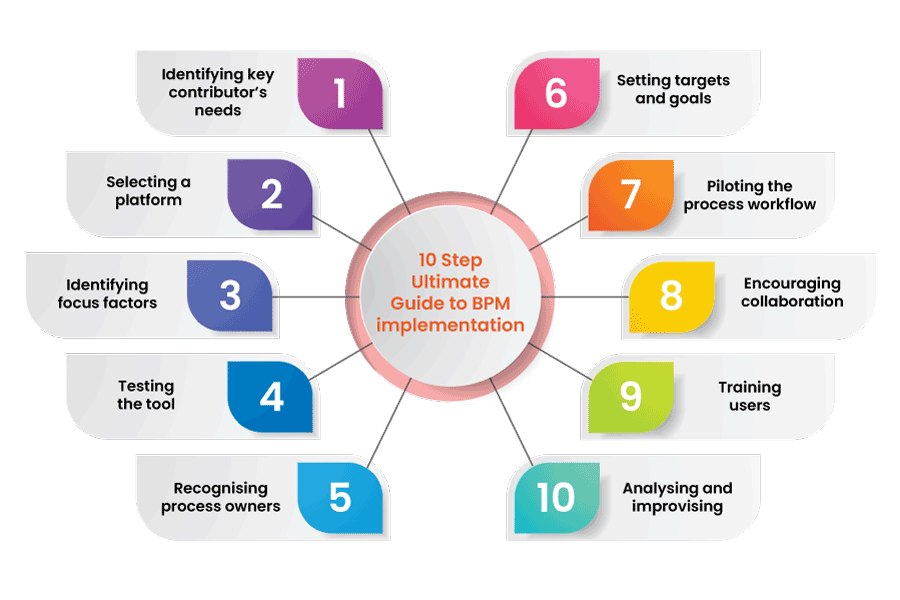
Did you know that any working personnel averagely spend three hours of their day on insignificant tasks? The statistics are shocking. But we are fortunate to witness methods and solutions to reduce the wastage of time, energy, and monetary resources.
Every organization today is working towards achieving the wider objective, it could be scaling up the current working process or improving employees’ efficiency. These targets seem quantifiable and achievable provided there is a methodical BPM implementation.
Business process management is one such process that aligns organizational functions with consumer needs and ensures effective deployment of company resources. With the right process implementation by the right company on your side, you can leverage the resources in the best form.
As a significant part of the company, you would want the best service that helps you keep your business operations in check and also allow you to analyze the loopholes. We suggest implementing BPM. And if it is a no-code solution, you can envision leaps and bounds of success.
Also read: BPM Software – 10 things to consider to choose the right one
10-step BPM implementation checklist
The following is a checklist for Business Process Management implementation that will keep you away from the anxiety and stress of a late-running project or unmet deadlines.

1. Identifying key contributor’s needs
The first step to achieving a successful BPM operation recognizing the needs of the stakeholders of the company is essential. Every individual has a different persona of working with/in your organization. As a key decision-maker, you need to understand their requirements and the barriers.
Once done, you will get a new perspective on the problems that need to be addressed. Both the technical and functional operators play a crucial part in BPM implementation, and considering their advice can help you in further processes.
2. Selecting a platform
The platform you choose and the processes you implement are directly proportional to the effectiveness of the BPM implementation. Since you have decided to inculcate business process management in your organization, you must choose the right foundation. The better the platform, the better is the performance.
The market is overcrowded with tools that are either focused on operation management or documentation. But, the path towards disruptive innovation can only be achieved if the key stakeholders’ needs and business requirements are kept in mind. You need a self-service software solution that is easy to understand even for a non-technical user. With a no-code tool, that allows users to build solutions without any technical complexities, you can ensure that the team can easily troubleshoot operational discrepancies.
The better the platform, the better is the performance.
3. Identifying focus factors
Most corporations have understood the importance of an easy no-code BPM tool. But only understanding the necessity is not enough. The key processes where you have to incorporate these changes are also important. You must get answers to the questions like
- Why do you want no-code BPM implementation?
- What process do we need to focus on?
- What result do we expect from the implementation?
- Where do the organizational activities lag?
- What changes can help bridge the gap?
4. Testing the tool
Testing the no-code BPM solution that you have selected can help you understand the functionalities better. After running a test, you can finalize what processes can be automated and what is not up to the efficiency mark. Automating complex procedures seems difficult. But with a manageable tool, you can avoid redundancy.
An ergonomic no-code tool that computerizes even the most complex procedures. Also, beginning on a small scale will allow you to find answers to whether the no-code BPM software is capable of transforming the organization positively. So, you must monitor the test closely.
5. Recognising process owners
Any new addition to the company, whether process or department, can make it an authority-responsibility battleground. But with self-service business process management software, you can avoid the circumstance. The tool becomes the process owner. For the successful running of your business process, it is imperative to assign process owners who take responsibility for their actions. A tool that lets you build bespoke solutions is the ideal one. When everyone knows their roles, responsibilities, and authorities, you can expect smooth functioning.
Also read: 10 Valuable Benefits of Business Process Management
6. Setting targets and goals
Can any organization work without an objective? The question seems absurd. The answer is an obvious “no”. Just like it is essential to have organizational goals, it is also crucial to have benchmarks associated with the business process management implementation.
Setting standards allows you to track daily performances, improvements, and scope of work. When you have a set objective of what you wish to achieve from the no-code BPM operation tool, you can prioritize the tasks and leverage the benefit of utmost efficiency. Implementing case management, for example, as part of your BPM strategy helps your organization achieve consistency in handling similar cases, standardizing processes where possible while allowing for flexibility and customization when required.
Also Read: Top 15+ Business Process Automation Examples You Need to Know
7. Piloting the process workflow
To ensure a successful pilot test of the process workflow, it is essential to first conduct a comprehensive business process mapping exercise, which involves documenting and analyzing the current processes to identify areas of improvement and automation.
The process workflow that you have enumerated through the no-code BPM solution also needs a pilot test. You must see if the implemented BPM affects the existing processes or not. Whether it is about the actual processing time, data amount tolerance, or result quality. Initially, it is important to see if they affect the current standards negatively. When you see the output, you can feasibly understand what processes can be automated. Else, you need to reconsider.

8. Encouraging collaboration
As discussed above, technical personnel who know the usage and implementation of the no-code BPM platform and functional workers who know how to run the process. Everyone under these two heads plays a critical role in successfully implementing business process management. When everyone has a significant say and the right to give feedback, strategizing becomes simpler.
9. Training users
BPM significantly improves efficiency and removes redundancy. Training your team about their responsibilities, wherever and whenever needed, determines how effectively you can see the result of the BPM. Albeit the no-code platform for business process management in your company is understandable, it would be best if you conduct a workshop for its better application by the team.
10. Analysing and improvising
The analysis accounts for the most imperative part of the entire process. After every step of the BPM checklist, you need to create an analysis statement to know if the automation process, integration of no-code business process, etc., has created a positive impact or not. Although no-code helps in adapting the software to your existing processes without hampering the process. It is still important for leaders to encourage employees to adopt the changes for better performance.
If you track the impact, you can see the deviations and take corrective measures. The process owners that you have assigned must be in charge of measuring the action and performance.
Summing up
BPM is a structure that allows your organization to exploit its competitiveness. It is a seamless composition of designing, monitoring, supervising, and integrating distinctive tasks of the organization. With BPM implementation, you can be sure that even the minutest tasks are being monitored. Also, the no-code solution gives you the scope to create a digitally-advanced work environment with improved efficiency.
The multiple tasks happening in your company need your attention and automation is the need of the hour. And our effective BPM solution, which is incorporated with no-code citizen development and efficient IT assistance, lets you computerize all possible tasks.
At Quixy, we offer BPM no-code software that lets you build custom solutions without having to write any code. With this automated self-service tool, you can define the processes intuitively without worrying about the hard work needed. Whether it is about agility, transparency, or consistency, the no-code BPM tool is the solution.
Our state-of-the-art no-code software allows you to deploy and manage business processes without any hindrance to daily activities.
Subscribe
Login
Please login to comment
0 Comments
Oldest
















